Gallery: Bathsheba Grossman
by Raven Hanna
Based on mathematical structures, Bathsheba Grossman's metal artworks are an example of digital sculpture given form.
| "The universe is orderly and friendly and beautiful. Structure is this lovely, versatile thing."  "It's either right or it's wrong. It's either elegant or not elegant. In math, those are actual properties. Everyone agrees." |
Bathsheba Grossman carries around her art wherever she goes. She shows strangers her two-inch metal sculptures, the babies of her collection. People hold them, stare at them, love them, and buy them. In this way, she has sold on the spot to barmaids, secretaries, bus drivers, and mail deliverers.
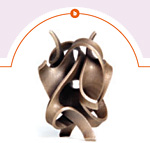 b. Antipot |
The sculptures themselves are their own best marketing. After selling a sculpture to Microsoft's Mark Zbikowski, famous to computer geeks and business buffs for developing MS-DOS software, she watched requests from other Microsoft employees roll in. Grossman makes art people want.
"I think they say something important about the human mind," Grossman says of her sculptures. She speaks quickly, accurately, and with an authoritative tone. "It gratifies a need most people aren't aware of—for order. The universe is orderly and friendly and beautiful. Structure is this lovely, versatile thing."
Her sculptures rise in twists and arch into knots of satisfyingly heavy darkish metal. They have structure and order, yet their symmetries are hard to grasp. As you attempt to trace the labyrinthine formations, you are drawn in, mesmerized.
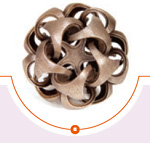 c. Quintron |
Although her sculptures look mathematical, the quantitatively-challenged are not put off. "A lot of people who don't know anything about math or science buy these things," she says. "There's a lot of raw appeal. People approach them in different ways, but almost everybody sees that they are of interest."
Grossman grew up in a middle-class neighborhood in Massachusetts with English professor parents. At Yale University, she shirked the family tradition by pursuing a degree in mathematics. "I loved it," she says. "I like avoiding ambiguity. It's either right or it's wrong. It's either elegant or not elegant. In math, those are actual properties. Everyone agrees."
Grossman's introduction to art came through university general education requirements. She sculpted nude models under the direction of Erwin Hauer, a German professor who prized measurement and accuracy. After three years of Hauer's instruction, she visited his workshop and saw his sculptural renderings of minimal surfaces and symmetrical shapes. "I walked in a math major, and when I walked out my life was changed," she says. "'If that's sculpture, I want to be an artist!' I thought, 'I want to go on in sculpture. I want to sculpt this stuff.'"
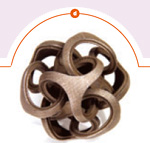 d. Metatron |
Grossman knew what she wanted to do, but she needed training. She finished her math degree, then headed to the University of Pennsylvania to earn an MFA in sculpture. In art school, she learned the laborious process of making sculptures by hand, taking them to the foundry, and casting them into metal. She realized with dismay that, by using this lengthy process, she could only make a few per year.
Then on a fateful day in the late 1990s, Grossman discovered a then-new technology called 3D printing. A few companies were pioneering the procedure, which uses lasers to mark areas in a resin block. Areas touched by a laser turn hard and can be separated from the virgin medium. She learned that almost any 3D object could be sculpted in this manner, if directions were given to the printer in an appropriate Computer Aided Design (CAD) format. Immediately sensing the power this new technique held for her work, Grossman devoted a month to learning to use CAD software. She never looked back.
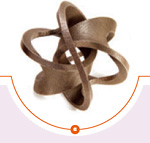 e. Soliton |
True to her classical sculpture training, Grossman's current process starts with modeling clay. "It's like a figure-eight-shaped blackboard," she says while holding a softball size piece-greenish, bulky but carefully smoothed, and formed into a knotted structure. "I can draw whatever I want on it. I can put a design on it to show the structure. I want to pull out the things that are elegant. I want to find out what exactly it is that interests me about this."
She searches for a way to maintain the basic structure she has modeled, but somehow camouflage it in details. "Everyone understands a figure-eight knot, and still I hope this is going to be a profound object," she says. "It's so simple anyone can understand it, and yet you can stare at it for hours and still have no idea what is really going on."
Grossman says her sculptures are based on symmetry point groups, a very mathematical idea, but that their execution is born from an art aesthetic, not math. Although she doesn't attempt it, she assumes that her sculptures could be reduced to relatively simple equations. "Strangely, it works that way," she says. "What is beautiful converges to what is mathematical."
 f. Nexus 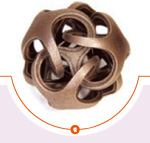 g. Metatrino |
As Grossman explores the potential of her clay sketch, she tackles the possibilities in the CAD program. Modeling the geometries is complex and takes around three months to complete. Once satisfied she transfers the electronic data file to a company that can directly laser print metal. Weighty, metal sculptures arrive at her door.
Grossman marvels at this process. In it she sees a new horizon: digital sculpture. All the arts are doing it. Language was always ready for digitization and could be copied, she explains, but the advent of printing made the process easier. Paintings became digital, their images copied to countless books, pages and slides. Music has also become digital. Sculpture has lagged behind. "I'm not really making objects," Grossman says. "I happen to be making objects, but the core of what I'm doing is creating the design."
Grossman looks forward to the day when anybody can download her designs and have them printed, in any size and any material, at the local copy shop. Maybe not in 20 years—certainly in 50—she says, but it's coming, and it's going to be revolutionary. "We're currently standing next to the Gutenberg press watching the first Bible come off and thinking 'you know, we're on to something here.' It's that important. And it doesn't matter whether I make money out of it. What matters it that in the end I have the satisfaction of having seen this coming."
What also matters in the end is the art itself, the immortality of her designs. "In a thousand years," says Grossman, "wherever it is on the earth, if you are a sentient being, you will know that this is art." And any sentient being is likely to be charmed by the complexities of her artistically and mathematically elegant sculptures.
Click here to download the pdf version of this article.






